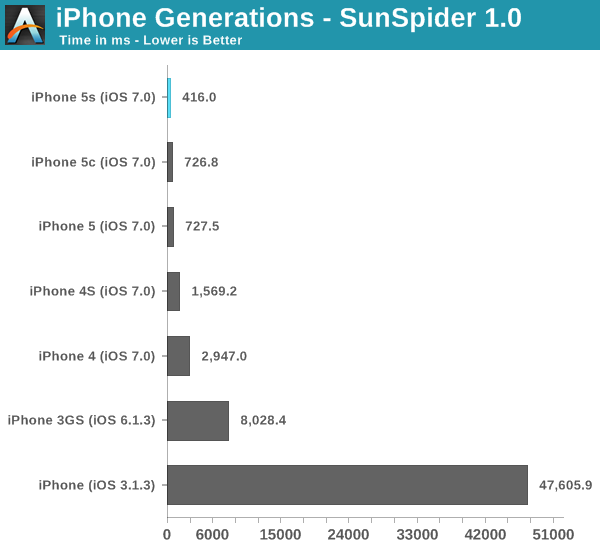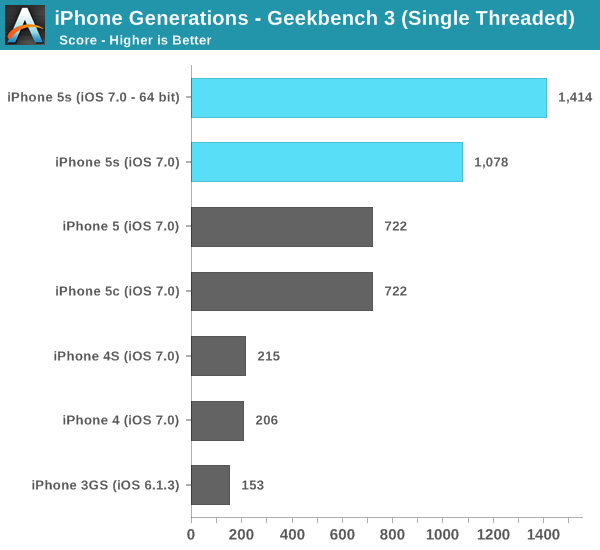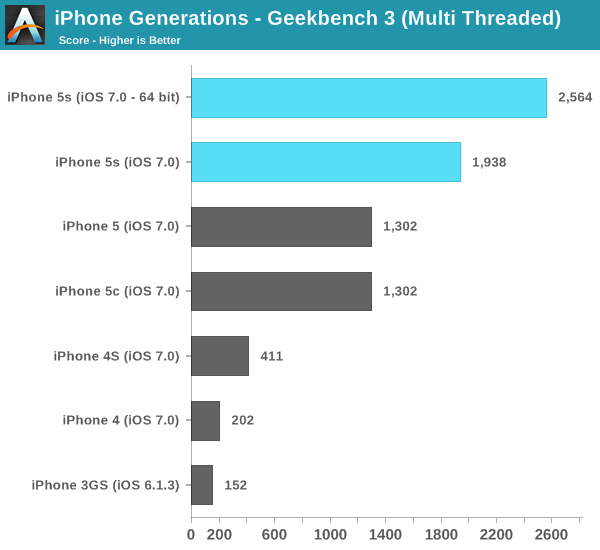The iPhone 5s Review
by Anand Lal Shimpi on September 17, 2013 9:01 PM EST- Posted in
- Smartphones
- Apple
- Mobile
- iPhone
- iPhone 5S
iPhone Performance Across Generations

Performance improved by a factor of 100x compared to the original iPhone. You can cut that in half if the iPhone could run iOS 4. Needless to say, Apple's CPU performance estimates aren't unreasonable. We've come a long way since the days when ARM11 cores were good enough.
Even compared to a relatively modern phone like the iPhone 4, the jump to a 5s is huge. The gap isn't quite at the level of an order of magnitude, but it's quickly approaching it. Using the single core iPhone 4 under iOS 7 just feels incredibly slow. Starting with the 4S things get a lot better, but I'd say the iPhone 4 is at the point now where it's starting to feel too slow even for normal consumers (at least with iOS 7 installed).

Browsermark 2.0 gives us a good indication of less CPU bound performance gains. Here we see over a 5x increase in performance compared to the original iPhone, and an 83% increase compared to the iPhone 4.
I wanted to have a closer look at raw CPU performance so I turned to Geekbench 3. Unfortunately Geekbench 3 won't run on anything older than iOS 6, so the original iPhone bows out of this test.

Single threaded performance scaled by roughly 9x from the 3GS to the iPhone 5s. The improvement since the iPhone 4/4S days is around 6.5x. Single threaded performance often influences snappiness and UI speed/feel, so it's definitely an important vector to scale across.

Take into account multithreaded performance and the increase over the 3GS is even bigger, almost 17x now.
The only 3D test I could get to reliably run across all of the platforms (outside the original iPhone) was Basemark X. Again I had issues getting Basemark X running in offscreen mode on iOS 7 so all of the tests here are run at each device's native resolution. In the case of the 3GS to 4 transition, that means a performance regression as the 3GS had a much lower display resolution to deal with.

Apple has scaled GPU performance pretty much in line with CPU performance over the years. The 5s scores 15x the frame rate of the iPhone 4, at a higher resolution too.
iPhone 5s vs. Bay Trail
I couldn't help but run Intel's current favorite mobile benchmark on the iPhone 5s. WebXPRT by Principled Technologies is a collection of browser based benchmarks that use HTML5 and js to simulate a number of workloads (photo editing, face detection, stocks dashboard and offline notes).

Granted we're comparing across platforms/browsers here, but the 5s as a platform does extremely well in Intel's favorite benchmark. The 5c by comparison performs a lot more like what we'd expect from a smartphone platform. The iPhone 5s is in a league of its own here. While I don't expect performance equalling the Atom Z3770 across the board, the fact that Apple is getting this close (with two fewer cores at that) is a testament to the work done in Cupertino.
At its launch event Apple claimed the A7 offered desktop class CPU performance. If it really is performance competitive with Bay Trail, I think that statement is a fair one to make. We're not talking about Haswell or even Ivy Bridge levels of desktop performance, but rather something close to mobile Core 2 Duo class. I've broken down the subtests in the table below:
| WebXPRT Performance (time in ms, lower is better) | ||||||
| Chrome/Mobile Safari | Photo Effects | Face Detection | Stocks | Offline Notes | ||
| Apple iPhone 5s (Apple A7 1.3GHz) | 878.9 ms | 1831.4 ms | 436.1 ms | 604.6 ms | ||
| Intel Bay Trail FFRD (Atom Z3770 1.46GHz) | 693.5 ms | 1557.0 ms | 542.9 ms | 737.3 ms | ||
| AMD A4-5000 (1.5GHz) | 411.2 ms | 2349.5 ms | 719.1 ms | 880.7 ms | ||
| Apple iPhone 5c (Apple A6 1.3GHz) | 1987.6 ms | 4119.6 ms | 763.6 ms | 1747.6 ms | ||
It's not a clean sweep for the iPhone 5s, but keep in mind that we are comparing to the best AMD and Intel have to offer in this space. I suspect part of why this is close is because both of those companies have been holding back a bit (there's no rush to build the fastest low margin parts), but it doesn't change reality.










464 Comments
View All Comments
Wilco1 - Wednesday, September 18, 2013 - link
If all you can do is name calling then you clearly haven't got a clue or any evidence to prove your point. Either come up with real evidence or leave the debate to the experts. Do you even understand what IPC means?For example in your link a low clocked Jaguar is keeping up with a much higher clocked Bay Trail (yes it boosts to 2.4GHz during the benchmark run), so the obvious conclusion is that Jaguar has far higher IPC than Bay Trail. For example Jaguar has 28% higher IPC than BT in the 7-zip test. Just like I said.
Now show me a single benchmark where BT gets better IPC than Jaguar. Put up or shut up.
zeo - Wednesday, September 18, 2013 - link
The point that BT Beats Jaguar, especially at performance per watt, clearly proved the point given!And insisting as you are on your original assessment is a characteristic of acting like a Troll... So you're not going to convince anyone by simply insisting on being right... especially when we can point to Anandtech pointing out multiple benchmarks in this article that showed the Kabini performing lower than bother BT and the A7!
So either learn to read what these reviews actually post or accept getting labeled a Troll... either way, you're not winning this argument!
Wilco1 - Wednesday, September 18, 2013 - link
No, Bob's claim was that Bay Trail was faster clock for clock than Jaguar, when the link he gave to prove it clearly showed that is false. BT may well beat Jaguar on perf/watt, but that's not at all what we were discussing.So next time try to understand what people are discussing before jumping in and calling people a Troll. And yes I stand by my characterization of various microarchitectures, precisely because it's based on actual benchmark results.
Bob Todd - Wednesday, September 18, 2013 - link
IPC as a comparison point made a lot of sense when we were arguing about which 130 watt desktop processor had the better architecture. It seems largely irrelevant for mobile where we care about performance per watt. Your argument is continually that the ARM/AMD designs are 'faster' based on Geekbench. If Jaguar has a 28% higher IPC than Bay Trail, do you honestly think it matters if Bay Trail is still the faster chip @ 1/3 (or less) of the power requirements? If someone came up with a crazy design that needed 5x the clocks to have a 2x performance advantage of their competitor, but did so with half the power budget, they'd still be racking up design wins (assuming parity for all other aspects like price). That's a two way street. If ARM designs a desktop/server focused chip that needs higher clocks than Intel to reach performance parity or be faster than Haswell, but does so with significantly less power it's still a huge win for them.Wilco1 - Wednesday, September 18, 2013 - link
IPC matters as you can compare different microarchitectures and make predictions on performance at different clock speeds. I'm sure you know many CPUs come in a confusing variation of clockspeeds (and even different base/turbo frequencies for Intel parts), but the underlying microarchitecture always remains the same. You can't make claims like "Bay Trail is faster than Jaguar" when such a claim would only valid at very specific frequencies. However we can say that Jaguar has better IPC than BT and that will remain true irrespectively of the frequency. So that is the purpose of the list of microarchitectures I posted.I was originally talking about the performance of Apple A7 and Bay Trail in Geekbench. You may not like Geekbench, but it represents close to actual CPU performance (not rubbish JavaScript, tuned benchmarks, cheating - remember AnTuTu? - or unfair compiler tricks).
Now you're right that besides absolute performance, perf/W is also important. Unfortunately there is almost no detailed info on power consumption, let alone energy to do a certain task for various CPUs. While TDP (in the rare cases it is known!) can give some indication, different feature sets, methodologies, "dial-a-TDP" and turbo features makes them hard to compare. What we can say in general is that high-frequency designs tend to be less efficient and use more power than lower frequency, higher IPC designs. In that sense I would not be surprised if the A7 also shows a very good perf/Watt. How it compares with BT is not clear until BT phones appear.
Bob Todd - Wednesday, September 18, 2013 - link
Your point about benchmarks is actually what surprises me the most nowadays. The biggest thing every in-depth review of a new ARM design brings to light is how freaking piss poor the state of mobile benchmarking is from a software standpoint. I didn't expect magic by the time we got to A9 designs, but it's a little ridiculous that we're still in a state of infancy for mobile benchmarking tools over half a decade after the market really started heating up.Bob Todd - Wednesday, September 18, 2013 - link
And by "ARM design" I mean both their cores or others building to their ISA.Wilco1 - Thursday, September 19, 2013 - link
Yes, mobile benchmarking is an absolute disgrace. And that's why I'm always pointing out how screwed up Anand's benchmarking is - I'm hoping he'll understand one day. How anyone can conclude anything from JS benchmarks is a total mystery to me. Anand might as well just show AnTuTu results and be done with it, that may actually be more accurate!Mobile benchmarks like EEMBC, CoreMark etc are far worse than the benchmarks they try to replace (eg. Dhrystone). And SPEC is useless as well. Ignoring the fact it is really a server benchmark, the main issue is that it ended up being a compiler trick contest than a fair CPU benchmark. Of course Geekbench isn't perfect either, but at the moment it's the best and fairest CPU bench: because it uses precompiled binaries you can't use compiler tricks to pretend your CPU is faster.
akdj - Thursday, September 19, 2013 - link
SO.....what is it the 'crew' is supposed to 'do'? NOT provide ANY benchmarks? Anand and team are utilizing the benchmarks available right now. They're not building the software to bench these devices...they're reviewing them...with the tools available, currently, NOW---on the market. If you're so interested in better mobile benchmarking (still in it's infancy---it's only really been 5 years since we've had multiple devices to even test), why not pursue and build your own benchmarking software? Seems like it may be a lucrative project. Sounds like you know a bit about CPU/GPU and SoC architecture---put something together. Sunspider is ubiquitous, used on any and all platforms from desktops to laptops---tablets to phones, people 'get it'. As well, GeekBench is re-inventing their benchmarking software---as well, the Google Octane tests are fairly new...and many of the folks using these devices ARE interested in how fast their browser populates, how quick a single core is---speed of apps opening and launching, opening a PDF, FPS playing games, et al.Again---if you're not 'happy' with how Anand is reviewing gear (the best on the web IMHO), open your own site---build your own tools, and lets see how things turn out for ya!
Give credit where credit is due....I'd much rather see the way Anand is approaching reviews in the mobile sector than a 1500 word essay without benchmarking results because current "mobile benchmarking is an absolute disgrace"
YMMV as always
J
PS---Thanks for the review guys....again, GREAT Job!
Bob Todd - Thursday, September 19, 2013 - link
Umm...I think you missed my point. I love the reviews here. That doesn't change the fact that mobile benchmarking software sucks compared to what we have available on the desktop. That isn't a slam against this site or any of the reviewers, and I fully expect them to use the (relatively crappy) software tools that are available. And they've even gone above and beyond and written some tools themselves to test specific performance aspects. I'm just surprised that with mobile being the fastest growing market, nobody has really stepped up to the plate to offer a good holistic benchmarking suite to measure cpu/gpu/memory/io performance across at least iOS/Android. And no, I don't expect anyone at Anandtech to write or pay someone to write such a tool.